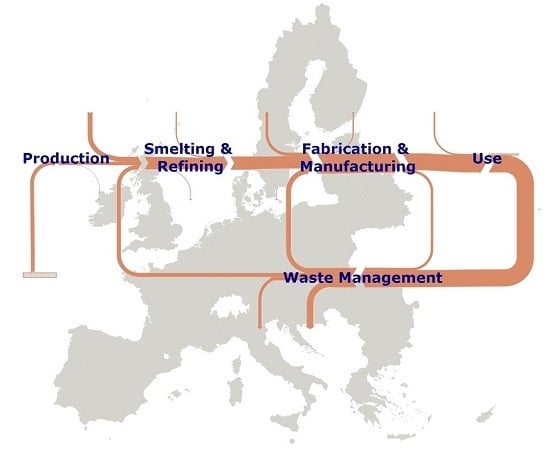Urban Mines of Copper: Size and Potential for Recycling in the EU
Abstract
:1. Introduction
2. Methods
2.1. The Anthropogenic Lifecycle of Cu
2.2. The European Cu Model
3. Results
3.1. The Contemporary Cu Cycle
3.2. Historic Evolution of Trade Flows of Cu
3.3. Accumulation of Cu in Regional Above-Ground Reserves
3.4. Cu Recycling Indicators
4. Discussion
5. Conclusions
Supplementary Materials
Acknowledgments
Author Contributions
Conflicts of Interest
Abbreviations
| C&D | Construction and demolition waste |
| Cu | Copper |
| EC | European Commission |
| ELV | End-of-life vehicle |
| EOL-RR | End-of-life recycling rate |
| EU-28 | European Union (28 Member States) |
| Gg | Gigagram (1 Gg = 1 × 109 grams (g) = 1 kilo metric tonnes (kt)) |
| IUD | In-use dissipation |
| IUS | In-use stock |
| IW | Electrical and non-electrical industrial waste |
| kg | Kilogram (1 kg = 1 × 103 grams (g)) |
| MSW | Municipal solid waste |
| NAS | Net-addition to in-use stock |
| NIR | Net-Import Reliance |
| Tg | Teragram (1 Tg = 1 × 1012 grams (g) = 1 million metric tonnes (Mt)) |
| TS | Temporary stock |
| UN COMTRADE | United Nations Commodity Trade Statistics Database |
| WEEE | Waste electrical and electronic equipment |
References
- U.S. Geological Survey (USGS), Mineral Commodity Summaries—Copper. Available online: https://minerals.usgs.gov/minerals/pubs/commodity/copper/mcs-2016-coppe.pdf (accessed on 20 January 2017).
- Northey, S.; Mohr, S.; Mudd, G.M.; Weng, Z.; Giurco, D. Modelling future copper ore grade decline based on a detailed assessment of copper resources and mining. Resour. Conserv. Recycl. 2014, 83, 190–201. [Google Scholar] [CrossRef]
- European Commission, Critical Raw Materials for the EU. Report of the Ad-hoc Working Group on Defining Critical Raw Materials; European Commission: Bruxells, Belgium, 2010. [Google Scholar]
- European Commission, Critical Raw Materials for the EU. Report of the Ad-hoc Working Group on Defining Critical Raw Materials; European Commission: Bruxells, Belgium, 2014. [Google Scholar]
- Buijs, B.S.H. Critical Thinking about Critical Minerals: Assessing Risks Related to Resource Security; German Geological Survey: Hannover, Germany, 2011. [Google Scholar]
- U.S. National Research Council (NRC). Minerals, Critical Minerals, and the U.S. Economy; The National Academies Press: Washington, DC, USA, 2008. [Google Scholar]
- U.S. Department of Energy (DOE). Critical Materials Strategy; DOE: Washington, DC, USA, 2010.
- British Geological Survey. Risk List 2011; British Geological Survey: Nottingham, UK, 2011. [Google Scholar]
- British Geological Survey. Risk List 2015; British Geological Survey: Nottingham, UK, 2015. [Google Scholar]
- Nassar, N.T.; Barr, R.; Browning, M.; Diao, Z.; Friedlander, E.; Harper, E.M.; Henly, C.; Kavlak, G.; Kwatra, S.; Jun, C.; et al. Criticality of the Geological Copper Family. Environ. Sci. Technol. 2012, 46, 1071–1078. [Google Scholar] [CrossRef] [PubMed]
- Ciacci, L.; Nuss, P.; Reck, B.K.; Werner, T.T.; Graedel, T.E. Metal criticality determination for Australia, the US, and the planet—Comparing 2008 and 2012 results. Resources 2016, 5. [Google Scholar] [CrossRef]
- Meinert, L.D.; Robinson, G.R.; Nassar, N.T. Mineral Resources: Reserves, Peak Production and the Future. Resources 2016, 5. [Google Scholar] [CrossRef]
- Ciacci, L.; Harper, E.M.; Nassar, N.T.; Reck, B.K.; Graedel, T.E. Metal Dissipation and Inefficient Recycling Intensify Climate Forcing. Environ. Sci. Technol. 2016, 50, 11394–11402. [Google Scholar] [CrossRef] [PubMed]
- Graedel, T.E.; Allwood, J.; Birat, J.P.; Buchert, M.; Hagelüken, C.; Reck, B.K.; Sibley, S.F.; Sonnemann, G. What Do We Know About Metal Recycling Rates? J. Ind. Ecol. 2011, 15, 355–366. [Google Scholar] [CrossRef]
- Glöser, S.; Soulier, M.; Tercero Espinoza, L.A. Dynamic Analysis of Global Copper Flows. Global Stocks, Postconsumer Material Flows, Recycling Indicators, and Uncertainty Evaluation. Environ. Sci. Technol. 2013, 47, 6564–6572. [Google Scholar] [CrossRef] [PubMed]
- Elshkaki, A.; Graedel, T.E.; Ciacci, L.; Reck, B.K. Copper demand, supply, and associated energy use to 2050. Glob. Environ. Chang. 2016, 39, 305–315. [Google Scholar] [CrossRef]
- Baccini, P.; Brunner, P.H. Metabolism of the Anthroposphere; Springer: Heidelberg, Germany, 1991. [Google Scholar]
- Haas, W.; Krausmann, F.; Wiedenhofer, D.; Heinz, M. How Circular is the Global Economy?: An Assessment of Material Flows, Waste Production, and Recycling in the European Union and the World in 2005. J. Ind. Ecol. 2015, 19, 765–777. [Google Scholar] [CrossRef]
- Hashimoto, S.; Tanikawa, H.; Moriguchi, Y. Where will large amounts of materials accumulated within the economy go?—A material flow analysis of construction minerals for Japan. Waste Manag. 2007, 27, 1725–1738. [Google Scholar] [CrossRef] [PubMed]
- Bogucka, R.; Kosińska, I.; Brunner, P.H. Setting priorities in plastic waste management—Lessons learned from material flow analysis in Austria and Poland. Polimery-W 2008, 53, 55–59. [Google Scholar]
- Kuczenski, B.; Geyer, R. Material flow analysis of polyethylene terephthalate in the US, 1996–2007. Resour. Conserv. Recycl. 2010, 54, 1161–1169. [Google Scholar] [CrossRef]
- Ciacci, L.; Passarini, F.; Vassura, I. The European PVC cycle: In-use stock and flows. Resour. Conserv. Recycl. 2016, in press. [Google Scholar] [CrossRef]
- Graedel, T.E.; Cao, J. Metal spectra as indicators of development. Proc. Natl. Acad. Sci. USA 2010, 107, 20905–20910. [Google Scholar] [CrossRef] [PubMed]
- Ayres, R.U.; Ayres, L.W.; Råde, I. The Life Cycle of Copper, Its Co-Products and By-Products. Eco Effic. Ind. Sci. 2002, 13, 1–210. [Google Scholar]
- Graedel, T.E.; Van Beers, D.; Bertram, M.; Fuse, K.; Gordon, R.B.; Gritsinin, A.; Kapur, A.; Klee, R.J.; Lifset, R.J.; Memon, L. Multilevel Cycle of Anthropogenic Copper. Environ. Sci. Technol. 2004, 38, 1242–1252. [Google Scholar] [CrossRef] [PubMed]
- Gerst, M.D. Linking Material Flow Analysis and Resource Policy via Future Scenarios of In-Use Stock: An Example for Copper. Environ. Sci. Technol. 2009, 43, 6320–6325. [Google Scholar] [CrossRef] [PubMed]
- Bertram, M.; Graedel, T.E.; Rechberger, H.; Spatari, S. The contemporary European copper cycle: Waste management subsystem. Ecol. Econ. 2002, 42, 43–57. [Google Scholar] [CrossRef]
- Rechberger, H.; Graedel, T.E. The contemporary European copper cycle: Statistical entropy analysis. Ecol. Econ. 2002, 42, 59–72. [Google Scholar] [CrossRef]
- Graedel, T.E.; Bertram, M.; Fuse, K.; Gordon, R.B.; Lifset, R.; Rechberger, H.; Spatari, S. The contemporary European copper cycle: The characterization of technological copper cycles. Ecol. Econ. 2002, 42, 9–26. [Google Scholar] [CrossRef]
- Spatari, S.; Bertram, M.; Fuse, K.; Graedel, T.E.; Rechberger, H. The contemporary European copper cycle: 1 year stocks and flows. Ecol. Econ. 2002, 42, 27–42. [Google Scholar] [CrossRef]
- Ruhrberg, M. Assessing the recycling efficiency of copper from end-of-life products in Western Europe. Resour. Conserv. Recycl. 2006, 48, 141–165. [Google Scholar] [CrossRef]
- Cencic, O.; Rechberger, H. Material flow analysis with software STAN. J. Environ. Eng. Manag. 2008, 18, 3–7. [Google Scholar]
- World Bureau of Metal Statistics (WBMS). World Metal Statistics Yearbook; World Bureau of Metal Statistics: Ware, UK, 1984–2010. [Google Scholar]
- Soulier, M.; Fraunhofer Institute for Systems and Innovation Research, Karlsruhe, Germany. Personal communication, 2016.
- Thomson Reuters GFMS. Copper Survey; Thomson Reuters: London, UK, 2013–2016. [Google Scholar]
- U.S. Geological Survey (USGS). Copper End-Use Statistics; Matos, G.R., Edelstein, D.L., Eds.; U.S. Geological Survey: Reston, VA, USA, 2005. [Google Scholar]
- United Nations Commodity Trade Statistics Database (UN COMTRADE). Available online: comtrade.un.org (accessed on 20 January 2017).
- Lossin, A. Copper. In Ullmann’s Encyclopedia of Industrial Chemistry; Wiley-VCH Verlag GmbH & Co. KGaA: Weinheim, Germany, 2000. [Google Scholar]
- Isbell, C.A. Copper Alloys. In Ullmann’s Encyclopedia of Industrial Chemistry; Wiley-VCH Verlag GmbH & Co. KGaA: Weinheim, Germany, 2000. [Google Scholar]
- Rechberger, H.; Cencic, O.; Fruhwirth, R. Uncertainty in material flow analysis. J. Ind. Ecol. 2014, 18, 159–160. [Google Scholar] [CrossRef]
- Copper Development Association (CDA). Available online: http://copperalliance.org (accessed on 20 January 2017).
- Ciacci, L.; Reck, B.K.; Nassar, N.T.; Graedel, T.E. Lost by Design. Environ. Sci. Technol. 2015, 49, 9443–9451. [Google Scholar] [CrossRef] [PubMed]
- Graedel, T.E.; Barr, R.; Chandler, C.; Chase, T.; Choi, J.; Christoffersen, L.; Friedlander, E.; Henly, C.; Jun, C.; Nassar, N.T. Methodology of Metal Criticality Determination. Environ. Sci. Technol. 2011, 46, 1063–1070. [Google Scholar] [CrossRef]
- Van Beers, D.; Graedel, T.E. Spatial characterisation of multi-level in-use copper and zinc stocks in Australia. J. Clean Prod. 2007, 15, 849–861. [Google Scholar] [CrossRef]
- Kapur, A. The future of the red metal—Scenario analysis. Future 2005, 37, 1067–1094. [Google Scholar] [CrossRef]
- Spatari, S.; Bertram, M.; Gordon, R.B.; Henderson, K.; Graedel, T.E. Twentieth century copper stocks and flows in North America: A dynamic analysis. Ecol. Econ. 2005, 54, 37–51. [Google Scholar] [CrossRef]
- Liu, G.; Müller, D.B. Centennial Evolution of Aluminum In-Use Stocks on Our Aluminized Planet. Environ. Sci. Technol. 2013, 47, 4882–4888. [Google Scholar] [CrossRef] [PubMed]
- Müller, D.B.; Wang, T.; Duval, B. Patterns of Iron Use in Societal Evolution. Environ. Sci. Technol. 2010, 45, 182–188. [Google Scholar] [CrossRef] [PubMed]
- International Copper Study Group (ICSG). ICSG Global Copper Scrap Research Project. Final Report and Statistical Annex; International Copper Study Group (ICSG): Lisbon, Portugal, 2010. [Google Scholar]
- European Commission. Directive 2000/53/EC of the European Parliament and of the Council of 18 September 2000 on End-of-Life Vehicles; European Commission: Bruxells, Belgium, 2000; p. 34. [Google Scholar]
- European Commission. Directive 2012/19/EU of the European Parliament and of the Council of 4 July 2012 on Waste Electrical and Electronic Equipment (WEEE); European Commission: Bruxells, Belgium, 2012; p. 34. [Google Scholar]
- Corder, G.D.; Golev, A.; Giurco, D. “Wealth from metal waste”: Translating global knowledge on industrial ecology to metals recycling in Australia. Miner. Eng. 2015, 76, 2–9. [Google Scholar] [CrossRef]
- Gregson, N.; Crang, M.; Fuller, S.; Holmes, H. Interrogating the circular economy: The moral economy of resource recovery in the EU. Econ. Soc. 2015, 44, 218–243. [Google Scholar] [CrossRef] [Green Version]
- Graedel, T.E.; Ciacci, L.; Reck, B.K. On the spatial dimension of the circular economy. 2016; under review. [Google Scholar]
- Dahmus, J.B.; Gutowski, T.G. What Gets Recycled: An Information Theory Based Model for Product Recycling. Environ. Sci. Technol. 2007, 41, 7543–7550. [Google Scholar] [CrossRef] [PubMed]
- Gutowski, T.G.; Sahni, S.; Allwood, J.M.; Ashby, M.F.; Worrell, E. The energy required to produce materials: Constraints on energy-intensity improvements, parameters of demand. Philos. Trans R. Soc. A 2013, 371. [Google Scholar] [CrossRef] [PubMed]
- Cullen, J.M.; Allwood, J.M. Mapping the Global Flow of Aluminum: From Liquid Aluminum to End-Use Goods. Environ. Sci. Technol. 2013, 47, 3057–3064. [Google Scholar] [CrossRef] [PubMed]
- Reuter, M.A.; Van Schaik, A.; Ignatenko, O.; De Haan, G.J. Fundamental limits for the recycling of end-of-life vehicles. Miner. Eng. 2006, 19, 433–449. [Google Scholar] [CrossRef]
- Modaresi, R.; Müller, D.B. The Role of Automobiles for the Future of Aluminum Recycling. Environ. Sci. Technol. 2012, 46, 8587–8594. [Google Scholar] [CrossRef] [PubMed]
- Gibney, E. Graphene conducts electricity ten times better than expected. Available online: http://www.nature.com/news/graphene-conducts-electricity-ten-times-better-than-expected-1.14676 (accessed on 20 January 2017).
- Giurco, D.; Petrie, J.G. Strategies for reducing the carbon footprint of copper: New technologies, more recycling or demand management? Miner. Eng. 2007, 20, 842–853. [Google Scholar] [CrossRef]
- Muchova, L.; Eder, P.; Villanueva, A. End-of-Waste Criteria for Copper and Copper Ally Scrap: Technical Proposals; EUR 24786 EN; Joint Research Centre—Institute for Prospective Technological Studies; Publications Office of the European Union: Luxembourg, 2011. [Google Scholar]
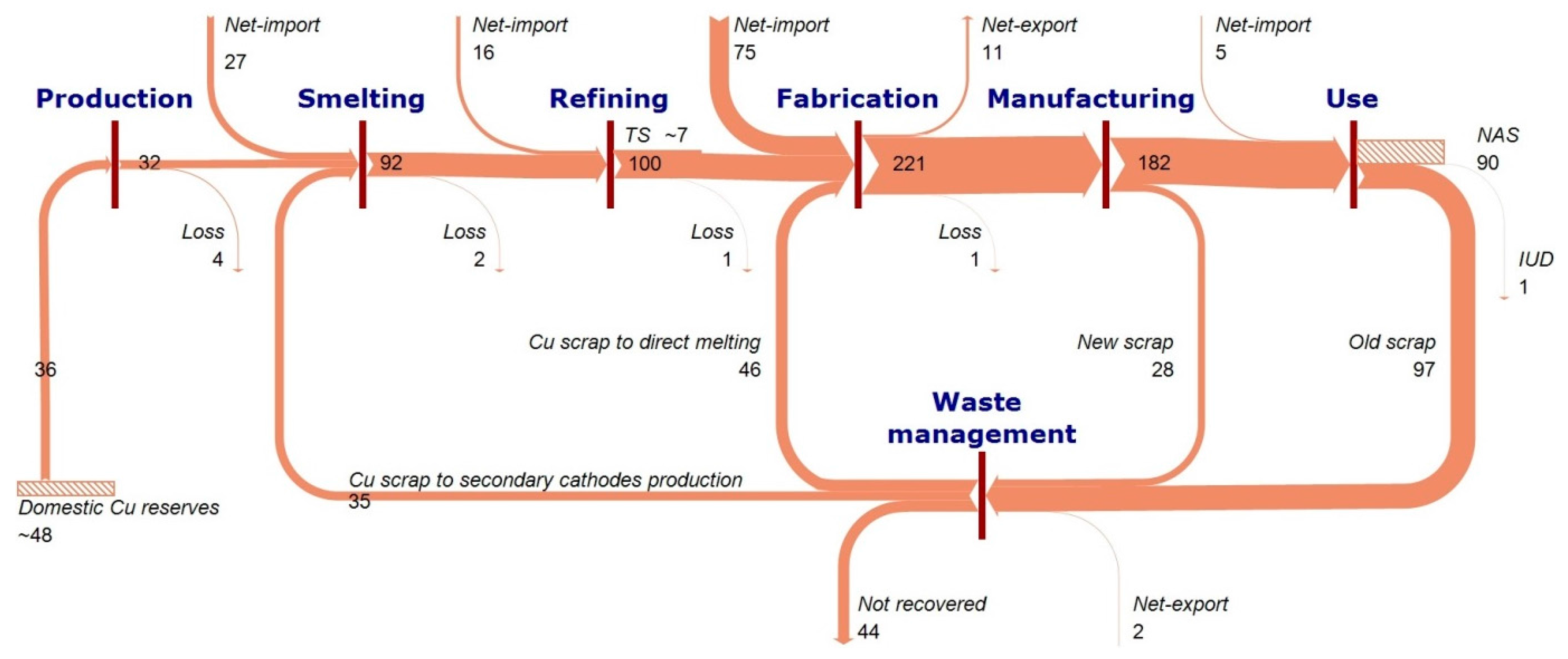
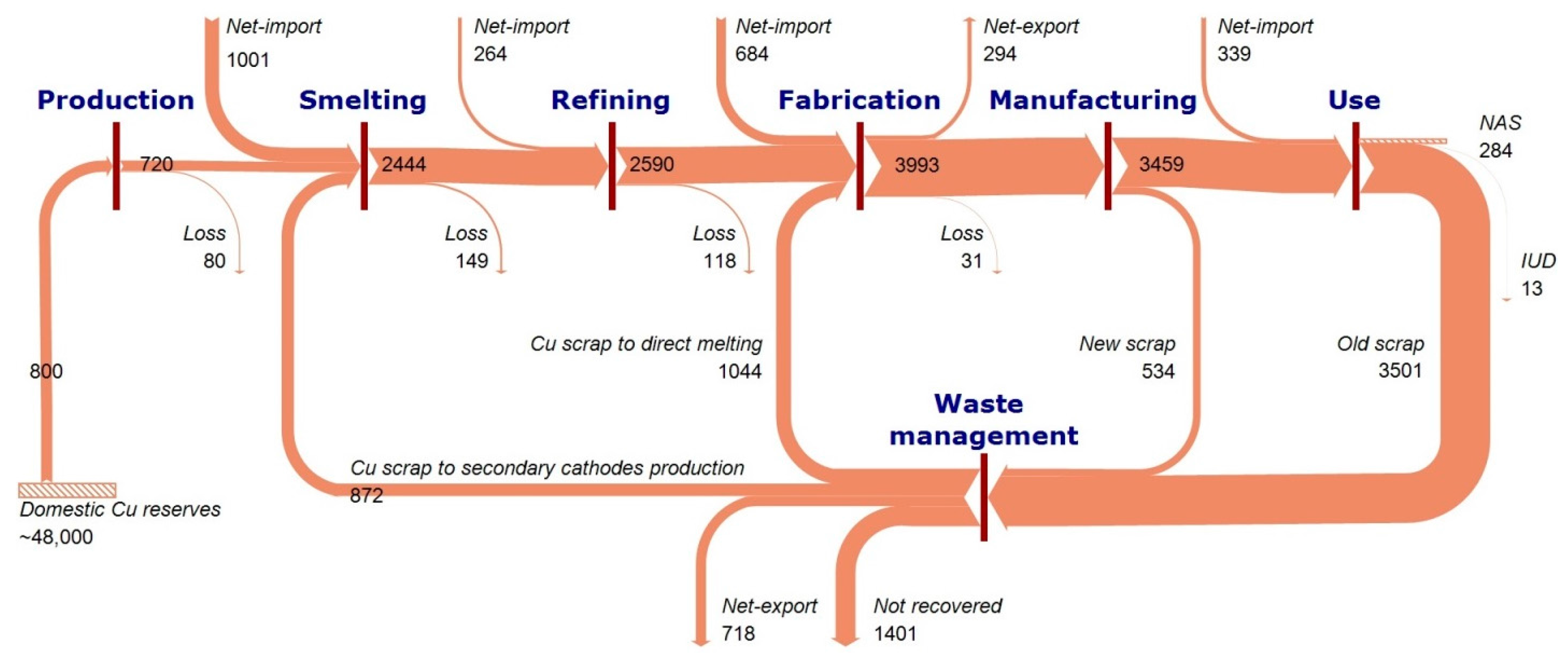
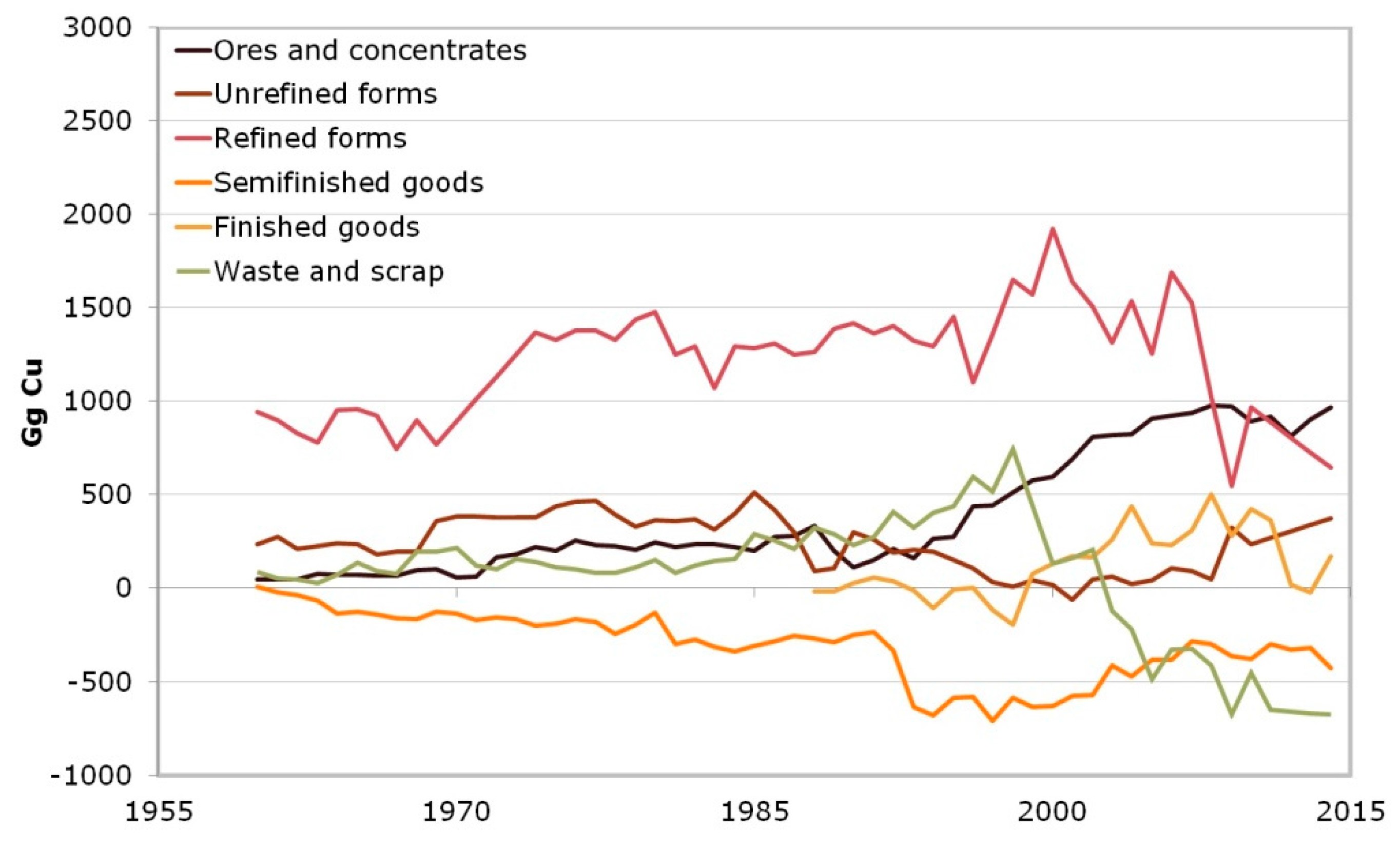
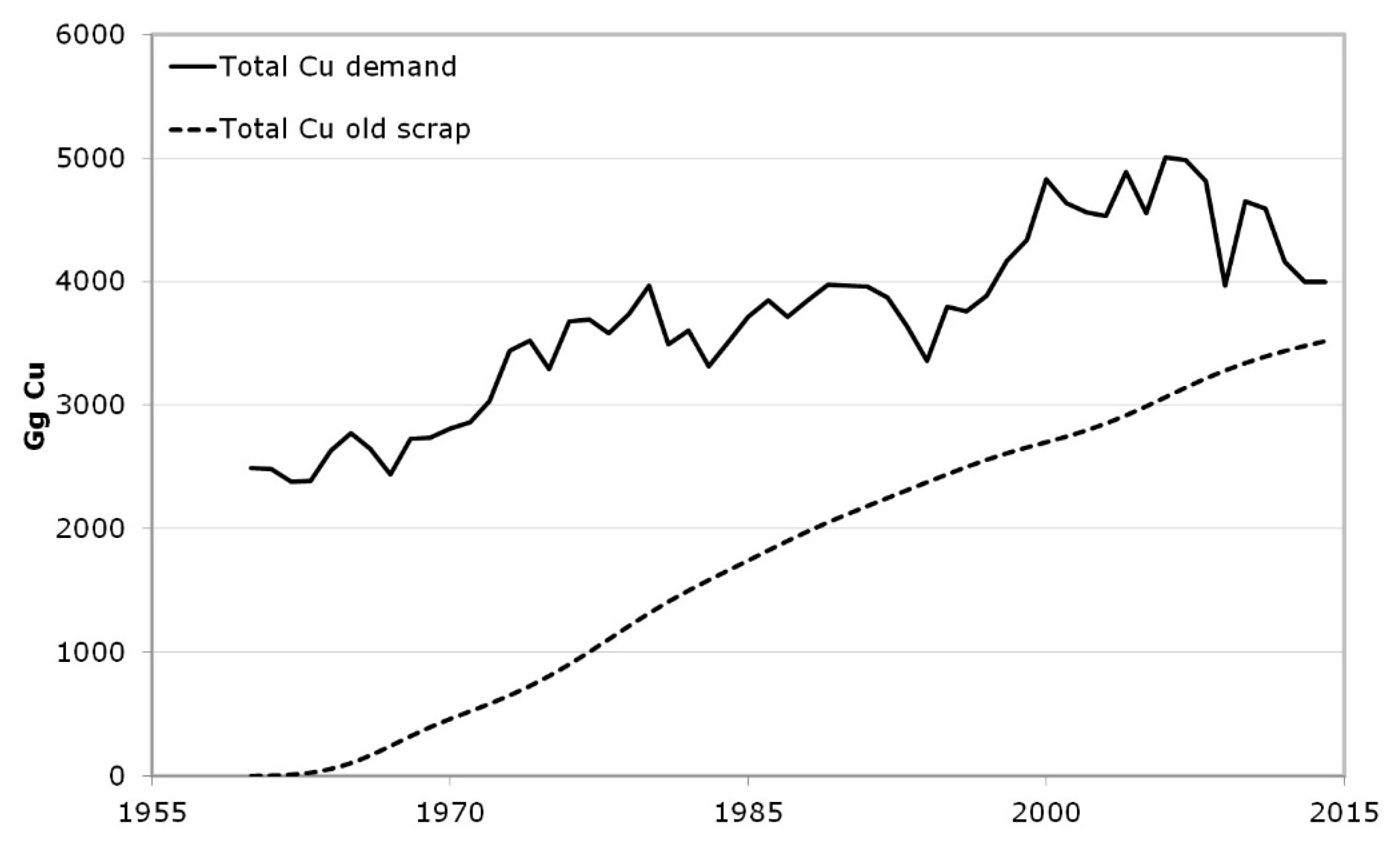
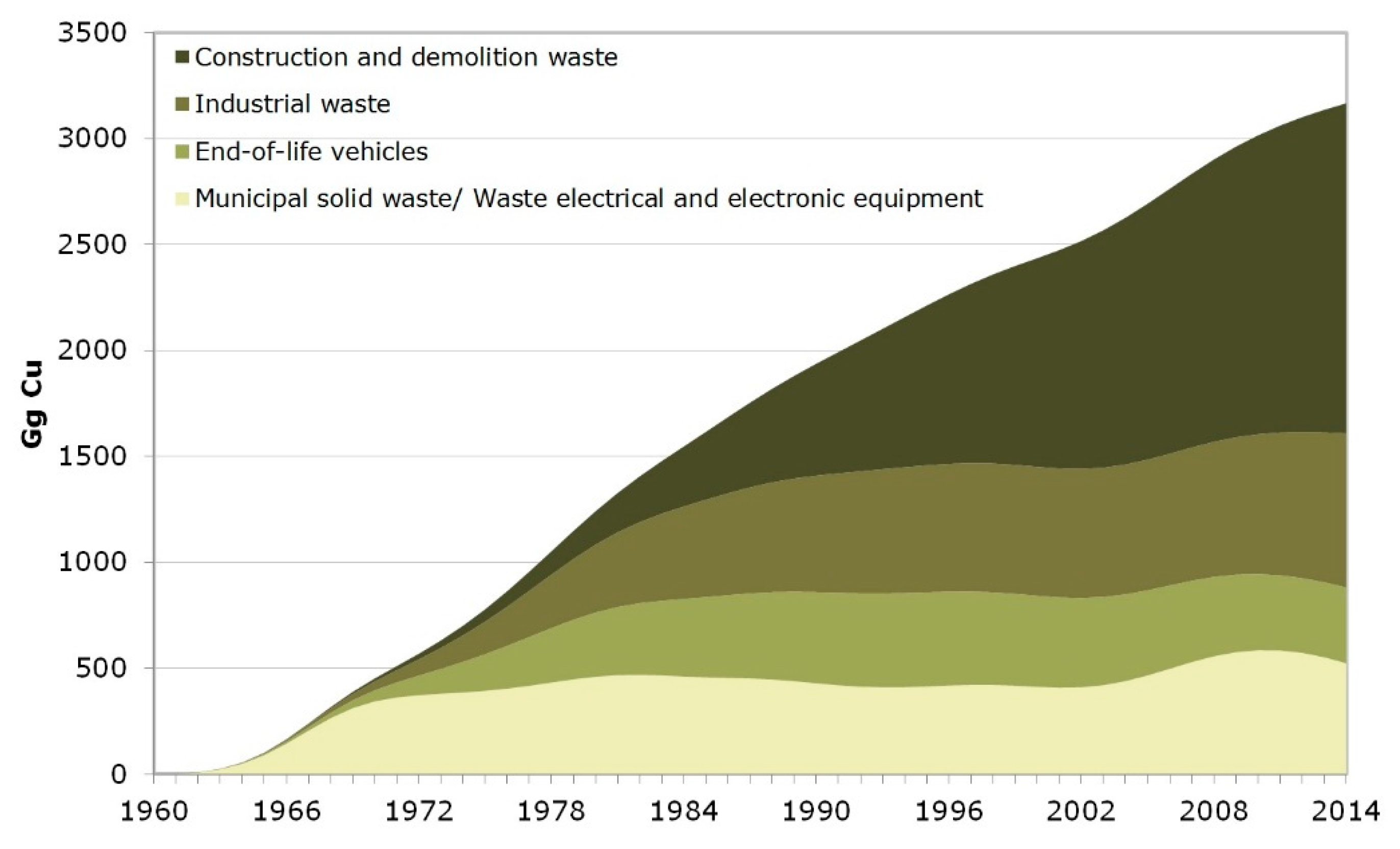
| End-Use Sector | Example of Application Included |
|---|---|
| Building and construction | Building wire; plumbing and heating; air conditioning and commercial refrigerator; builders hardware; architectural |
| Electrical and electronic products | Power utilities; telecommunications; business electronics; lighting and wiring devices |
| Industrial machinery and equipment | In-plant equipment, industrial valves and fittings, non-electrical instruments, off-road vehicles, heat exchangers |
| Transportation equipment | Automobile; truck and bus; railroad; marine, aircraft and aerospace |
| Consumer and general goods | Appliances, cord sets, military and commercial ordnance, consumer electronics, fasteners and closures, coinage, utensils and cutlery, miscellaneous |
© 2017 by the authors. Licensee MDPI, Basel, Switzerland. This article is an open access article distributed under the terms and conditions of the Creative Commons Attribution (CC BY) license ( http://creativecommons.org/licenses/by/4.0/).
Share and Cite
Ciacci, L.; Vassura, I.; Passarini, F. Urban Mines of Copper: Size and Potential for Recycling in the EU. Resources 2017, 6, 6. https://doi.org/10.3390/resources6010006
Ciacci L, Vassura I, Passarini F. Urban Mines of Copper: Size and Potential for Recycling in the EU. Resources. 2017; 6(1):6. https://doi.org/10.3390/resources6010006
Chicago/Turabian StyleCiacci, Luca, Ivano Vassura, and Fabrizio Passarini. 2017. "Urban Mines of Copper: Size and Potential for Recycling in the EU" Resources 6, no. 1: 6. https://doi.org/10.3390/resources6010006







